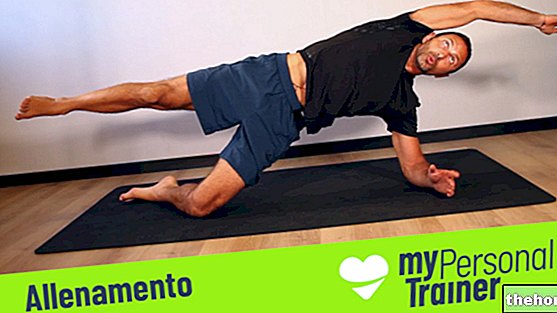
Obviously, to obtain satisfactory results it is essential to apply highly specific stimuli based on demonstrable scientific criteria.
For this reason, behind each type of training there are methods, sometimes different, but still approved by the community of motor scientists.
In the context of "training for strength and hypertrophy" there are basically two currents of thought that obviously exploit different systems; those who consider it essential to train to failure, and those who find it more useful to stay mainly in the buffer.
Both have positive and negative aspects but, below, we will examine buffer training because - although its importance and effectiveness has been demonstrated - objectively more "controversial".
(rep) programmed at each series (set), without reaching failure.
Applied to resistance training and (less) to calisthenics, buffer training requires proper management of one's reserve, with the specific objective of stimulating the muscles without exhausting them; later we will understand better why.
Buffer is therefore the opposite of muscle failure? Broadly speaking, yes, but it depends on the type of failure. We need to differentiate between technical failure, concentric, isometric and eccentric, because each is reached with very different load percentages.
An overhead used for the lowest level of buffer, for example - the most demanding, so to speak - would be almost superimposable to the technical failure (the one based on the inability to perform the last rep perfectly). On the contrary, it would be very far from the eccentric failure.
As we will see, the buffer allows you to modulate the intensity above all, but this does not mean that training in this way reduces the overall training load. On the contrary, often using the buffer allows you to increase the weekly frequency of stimuli, therefore both density and the volume.
For many, the buffer would apply mainly to multi-joint exercises (fundamental, for the "old generation"), responsible for a certain increase in metabolic and nervous fatigue, as well as peripheral; applications to monoarticulars and especially to small muscle groups, in which failure can be gained without major metabolic and nervous taxes, are minor and not very sensible.
Again in application terms, and albeit conceptually opposite, there are many who use the buffer to progressively reach exhaustion in an intelligent and progressive way.
On the other hand, there is a very important distinction to be made: not all activities use the buffer in the same way. Bodybuilders, powerlifters and those who train endurance to strength have a rather different concept of buffer, because different are the purpose and the athletic gestures mainly involved.
A powerlifter, for example, will use the buffer above all to optimize the multi-frequency in the micro-cycle of bench press, squat, deadlift, military press and rowing.
A bodybuilder, on the other hand, could take greater advantage of a buffer that allows him to increase especially the density (also of other exercises, such as horizontal press, chest press machine, horizontal pulley, etc.) inside the session itself.
In both cases, however, the buffer causes an increase in volume and a reduction in intensity.
at competitive levels at a young age it shows to have a greater congruence between perceived fatigue and organic fatigue; in essence, a better interpretation of physiological stimuli is appreciated.
Therefore, it would be inappropriate to apply buffer training in novice subjects, who have never internalized muscle failure proper and, probably, who have never learned the extent of their single maximal repetition (1 RM) - even if the "Buffer training can easily ignore the knowledge of your 1 RM.
We should also talk about the nutritional status, the motivation, the amount of night rest and recoveries etc., but we would leave the subject.
Instead, let's see on which criteria the degree of buffer is estimated. We are talking about the Borg score and the RPE scale, which are not synonymous with buffer, but in all probability they were the starting point from which this concept was born.
, the perceived exertion score (RPE) is measured by the Borg score on a dedicated scale.
It is a quantitative measure, used both in medicine and in athletic training to document the effort of the subject during a test or to evaluate the intensity of a training or competition.
The original scale, introduced by Gunnar Borg, rated effort on a scale of 6 to 20.
Borg then established a "further scale of the (R) category (C) ratio, the Borg CR10 scale, evaluated precisely on a scale from 1 to 10.
This is particularly used in the clinical diagnosis of dyspnoea, chest pain, angina and musculoskeletal pain.
The CR-10 scale is more applicable to sensations arising from a specific "area of the body, eg muscle pain, muscle fatigue, lung responses.
Borg's can be compared to other linear scales such as the Likert scale or the visual-analog pain scale.
The sensitivity and reproducibility of the results are substantially very similar, although in some cases the Borg scale exceeds that of Likert.
;The two objectives are closely linked, but not synonymous.
As the transverse section of the muscle increases, an increase in strength is appreciated in the same subject and, as a consequence of the pure training of this capacity, an increase in muscle mass occurs in the same subject.
Here, however, the real debate between the two currents of thought arises.
- On the one hand we have those who believe that hypertrophic growth and therefore of strength can only manifest itself by reaching a level of local stress so high as to force the organism to grow the contractile tissue in anticipation of another critical situation. Without exhaustion of the muscle, insufficient stimulation of the same would be obtained;
- On the other hand, those who believe that it is more effective to bring stimuli closer together and therefore numerically increase the stressful events while decreasing their entity; exhaustion of the muscle would result in a counterproductive dilation of recovery times.
Who is right and who is wrong? Neither and both.
In the sense that muscle growth responds to various mechanisms, some deriving from the failure of the resulting supercompensation, and others from the intrinsic mechanical expression of the gesture.
Then subjectivity comes into play; some grow and get stronger in one way and some don't.
However, almost always, by overturning the system and passing from one method to another, appreciable benefits are obtained. The password is therefore "vary", but with full knowledge of the facts.
And, in all of this, what would be the use of buffer training?
Buffer training is an excellent way to manage training load by modulating intensity, often increasing the volume and / or density and / or frequency of stimuli within the same micro cycle. Rep reserve training lends itself to the multi-frequency principle.
Furthermore, the buffer is particularly useful in dealing with periods of performance plateau.
Typical of those who are already seeking failure, and sometimes of those who excessively exhausts the muscle, these can limit growth and require to "slow down".
At this point, structuring a reasonable buffer (for example, with a progression) can allow you to recover just enough to regenerate and resume with the failure; this is a perfect example of complementarity between the two methods.
Let's sketch a quick explanation of how a training buffer management is structured.




























